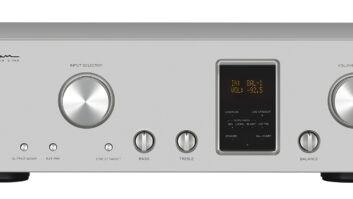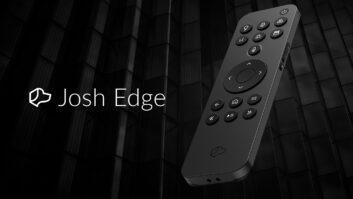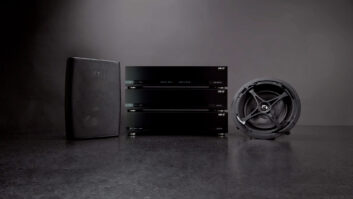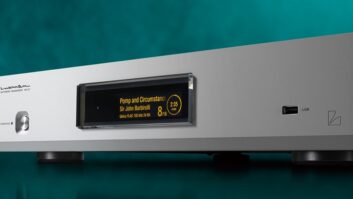IN OUR VIDEO-CENTRIC WORLD, AUDIO MAKES ITS CASE WITH NEW VOLUME BALANCING SOLUTIONS
In a business where the “newest, neatest and biggest” always seem to get the most attention, video often overshadows audio. But there have been important developments in the world of audio, namely automatic volume level adjustment technologies and the availability of advance audio codecs.
Though not on the scale with or of the same importance to room design and layout as was the move from 5.1 to 7.1 systems, the newest audio technology developments may answer some listener issues that your clients will see as just as valuable as more speaker positions, lossless compression, or higher bit rates. What we’re referring to is available under a variety of different trade names, but from a generic standpoint let’s put them under the overall umbrella of “automatic level adjusters.” At first glance, some might view these as modernday versions of “automatic gain control,” something that has been around in both the professional professional and consumer audio worlds going back to the analog era. Suffice to say that in the digital age things are considerably different.
Smoothing out volume level
While Dolby Volume, Audyssey Dynamic Volume, SRS TruVolume, THX Loudness Plus (though THX’s technology operates a bit differently and is not a full “loud to soft” level controller), and other branded and non-branded technologies take different approaches to the problem, the goal is to smooth out the differences in volume level from one program to another. With these technologies in place there is no more reaching for the volume control when switching between sources, channels, or even within a movie or program with sudden transitions from quiet scenes to loud explosions or passages.
Coming out of last month’s CEDIA EXPO, there was a great deal of noise about these different approaches. With all the publicity, it would be natural for someone to ask which is better. Not having had the opportunity to hear the different implementations in one place with the same program material, amplifiers, speakers and room acoustics, I can’t offer an answer at this time. It also should be mentioned that as with anything audio, this type of evaluation can become subjective and personal. At the end of the day it isn’t what I think best does the job, it is what you and your clients do.
You should keep in mind that it is unlikely that you will see more than one technology on the same product. This isn’t as simple as having the audio codecs from both Dolby and DTS on the same processor or receiver, and also on the same disc, and then doing a comparison. The reality is that if you determine that one technology is better than the other, you may have to switch model lines to offe devices with it, or otherwise you will have to be prepared to defend the way the competitive system works in the products that are otherwise your choice.
How to judge these systems
As with any level-control device, make sure that there is no “pumping”—listen for how well the level control preserves overall sound quality, as well as details such as maintaining dynamics without compromising bass performance, the ability to hear low-level background effects that might otherwise be lost in compression or leveling, and freedom from noise artifacts. You want the system to work as well when you set a high level and have everything come up to that setting without background noise, as when you set a low level and don’t’ want to have the sound be crushed so much that nuances in the soundtrack disappear. Make sure that the spectral balance is as smooth as the actual volume level.
If it seems that we’ve spent a bit too much time on this, we do so after not only hearing the various contenders, but also after explaining the concept to some non-technical friends. Their reaction was universal: “If this works, then it is really cool. I want it so that I can hear what I want without waking the baby during a late-night movie session.”
Put the availability of this in your system descriptions and prposal documents and be prepared to explain the benefits of the technology. You may find that you will have a new and valuable way to not only sell upgrades, but because the initial implementations of the various versions of the technologies are likely to be found in higher end products initially, a way to differentiate your product offerings from commodity choices.
Realize that these are not just technologies for separate audio products or AV receivers. As the new model lines appear from the display brands through the next product cycle, expect to see different versions begin to creep in. Promote that, as a two-channel solution to the problem of “I hate it when the volume keeps changing,” while at the same time, backing it up with product and system solutions that implement it across the full 7.1 soundfield.
Advanced audio codecs
At the high end, the ability to decode the new high bit rate (HBR) lossey and lossless audio codecs isn’t new. However, it is only within the recent product lines introductions from major audio brands that the ability to decode the native bitstreams for Dolby Digital Plus, Dolby TrueHD, DTS-HD High Resolution Audio, and DTSHD Master Audio has become fully available.
Dolby Laboratories senior marketing manager Craig Eggers explained Dolby Volume technology to CEDIA EXPO attendees last month in Denver. It goes without saying that you will want to make certain that the system in the “big room” is able to handle these advanced codecs, but don’t concentrate solely on the “big” part of the job. As digital television begets HDTV, and as HDTV requires HD sources, you will find, or be called upon to install, Blu-ray players throughout a home, not just in the theater. However, as you do drill further down into an installation with HD and Blu-ray, don’t forget the audio that goes with it.
With economic conditions more likely to influence equipment lists, beware of the impact of Bluray on audio when it replaces DVD in secondary locations. Some of the lower priced players are not equipped with internal decoding and 5.1 or 7.1 analog outputs for connection to a matching midor lower-end AVR that might be in an office, guest bedroom, teenager’s bedroom, or playroom. There, you can always make a connection via optical or coaxial S-P/DIF and have perfectly fine Dolby Digital or DTS core audio, but don’t hesitate to remind a reluctant client or prospect that with some players you may need to replace the AVR, as well, for the latest in audio technology.
Did we just say “playroom?” Keep in mind that if a PlayStation 3 is the game console of choice as well as the Blu-ray player, an HDMI 1.3 connection and an AVR (or standalone processor) with the ability to handle the HBR codecs is needed. With both PS 3 and with Xbox 360, there are no 5.1 or 7.1 analog outputs. Along the same lines, with Nintendo’s incredibly popular Wii game console, there is no digital audio output at all. That clearly means that any existing audio system will be compatible, but is the incumbent system able to take that analog output and use audio processing to take the stereo output from the game and transform it into a soundfield that is as immersive as the gaming action? Don’t forget that with all of the consoles, games such as Guitar Hero, Rock Band, SignStar and others are making audio a key part of the game. Make certain that you don’t miss the opportunity to take advantage of this where it might not be obvious to an uninformed prospect. With Wii Music now available, and with Lips due out for Xbox 360, the audio component of console gaming is in the ascendency. Be sure that you use that to your advantage by explaining the connection between games, Blu-ray players, and audio gear.
Know your download services
Using knowledge of what type of audio comes with which program sources is more than just for video games and Blu-ray. Here, it is more than just knowing the stream types, but also knowing how to take those streams and configure systems for maximum consumer enjoyment, particularly in the world of downloadable and streaming content. For example, the content for Netflix downloads on the forthcoming LG Blu-ray/Netflix connected player are 2.0, even though SD DVD or Blu-ray discs played in the same unit are in 5.1 or 7.1, as available on the disc.
On the other hand, other services are a mix of audio options. The HD downloads from iTunes are capable of 5.1 Dolby Digital audio, while SD downloads are not. As with any of the download movie services, the audio on Vudu’s content varies with that of the original program, but it, too, offers 5.1 Dolby Digital, and with both SD and HD titles. In fact, with Vudu’s recently announced HDX content upgrade, the available bit rate for digital audio has been increased to 640 kbps, identical to the Dolby Digital bit rate on Bluray discs.
To your clients, this can get very confusing. Here, you don’t need new audio technology to do the trick, but you do need to take care that the right modes are applied to the right (analog or 2.0) programming.
Remember audio
Unfortunately, audio is often the Rodney Dangerfield of our business, getting much less respect than the pretty pictures provided by 1080p video sources and displays. It’s important to remember, however, that without good audio, without the fine tuning that you can provide as a knowledgeable system designer, and without the gear that you provide and properly install, all the client has is a big bright picture and no emotion from the visceral impact that only audio can bring. Audio makes a picture seem better than it might be. Audio makes big pictures seem bigger. Video without good audio, no matter how high the definition, is like peanut butter without jelly.
Michael Heiss ([email protected]) is a technology guru for the AV industry, based in Los Angeles, California.







